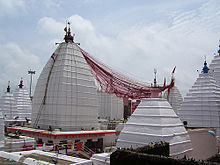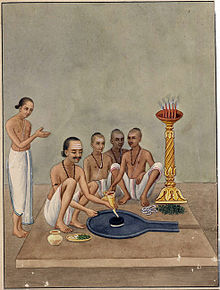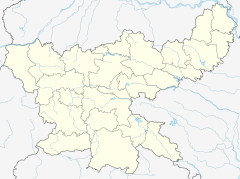Baidyanath Temple
| Vaidyanath Jyotirlinga, Deoghar | |
|---|---|
 Oil on canvas painting by William Hodges, 1782 | |
| Religion | |
| Affiliation | Hinduism |
| District | Deoghar |
| Deity | Baba Baidhyanath (Shiva) |
| Festivals | Maha Shivaratri, Shravani Mela |
| Governing body | Baba Baidyanath Temple Management Board |
| Location | |
| State | Jharkhand |
| Country | India |
| Geographic coordinates | 24°29′33″N 86°42′00″E / 24.49250°N 86.70000°E |
| Architecture | |
| Creator | Raja Puran Mal |
| Temple(s) | 22[1] |
| Website | |
| babadham.org | |

Vaidyanatha Jyotirlinga temple, also known as Baba Baidyanath dham and Baidyanath dham is one of the twelve Jyotirlingas, the most sacred abodes of Shiva. It is located in Deoghar in the Santhal Parganas division of the state of Jharkhand, India. It is a temple complex consisting of the main temple of Baba Baidyanath, where the Jyotirlinga is installed, and 21 other temples.[1]
According to Hindu beliefs, the demon king Ravana worshipped Shiva at the current site of the temple to get the boons that he later used to wreak havoc in the world. Ravana offered his ten heads one after another to Shiva as a sacrifice. Pleased with this, Shiva descended to cure Ravana who was injured. As he acted as a doctor, he is referred to as Vaidhya ("doctor"). From this aspect of Shiva, the temple derives its name.
Kanwar Yatra (Devanagari: कांवड़ यात्रा) is an annual pilgrimage of devotees of Shiva, known as Kānvarias(कावड़िया) or "Bhole" (भोले) to Hindu pilgrimage places of Sultanganj in Bihar to fetch holy waters of Ganges River. Millions of participants gather sacred water from the Ganga and carry it across hundreds of miles to dispense as offerings in Baidyanath Temple in Jharkhand.
Location of Baidyanath Jyotirlinga
Baidyanatham Chithabhoomau (1/21-24)[2] and Sivmahapuran Satarudra Samhita (42/1-4)[3] is the ancient verse that identifies location of Vaidyanth Jyotirlinga. According to which Baidyantham is in 'Chidabhoomi', which is the ancient name of Deoghar. In Dwadasa jyothirlinga sthothram, Adi Sankaracharya has praised Vaidyanath jyothirlinga in following verses,[4][5]
Poorvothare prajwalika nidhane
sada vasantham girija sametham
surasuraradhitha padapadmam
srivaidyanatham thamaham namami
This states that Vaidyanath jyotirlinga is located at Prajwalika nidhanam (meaning funeral place i.e., chithabhoomi) in the North-Eastern part of the country. Deoghar is far located in east compared to Parli which is in west-central part of the country. Also Chidabhoomi indicates that, in olden days, this was a funeral place, where corpses are burnt and post-death ceremonies were performed. This place could have been a center of tantric cults like Kapalika/Bhairava where Lord Shiva is worshipped significantly as smasan vasin (meaning, residing in crematorium), sava bhasma bhushita (meaning, smearing body with ashes of burnt bodies).[6]
While, the Dvadasalinga Smaranam has variation by which, verse is Paralyam Vaidyanatham, i.e., Vaidyanatham is in Parli, Maharashtra. The names and the locations of the 12 Jyotirlingas mentioned are:[7][8][9]
Saurashtre Somanathamcha Srisaile Mallikarjunam|
Ujjayinya Mahakalam Omkaramamaleswaram ||
Paralyam Vaidyanathancha Dakinyam Bheema Shankaram |
Setu Bandhethu Ramesam, Nagesam Darukavane||
Varanasyantu Vishwesam Tryambakam Gautameethate|
Himalayetu Kedaaram, Ghrishnesamcha shivaalaye||
Etani jyotirlingani, Saayam Praatah Patennarah|
Sapta Janma Kritam pApam, Smaranena Vinashyati||
Thus the three temples claiming their shrines as 'real' jyotirlinga of Vaidyanath are
- Baidyanath temple at Deoghar, Jharkhand,
- Vaidyanath temple at Parli, Maharashtra and
- Baijnath temple at Baijnath, Himachal Pradesh.[citation needed]
Bhavishyapurana also describes Baidyanath as follows:
"Narikhande is district abounding in thickets. It lies west of the Dwarikashwari River. It extends along the Panchakuta hills on its west, and approaches Kikta on the north. The forests are very extensive, chiefly of Sakhota, Arjuna and Sal trees with a plentiful addition of brushwood. The district is celebrated for the shrine of Baidyanath. The deity is worshiped by people from all quarters, and is the source of every good in the present age."
It is believed that, Shiva first manifested himself as a Jyotirlinga on the night of the Aridra Nakshatra, thus the special reverence for the Jyotirlinga. The same shrine of Vaidyanath is considered as one of 51 Shakti Peethas, where 'heart' of Sati (goddess) fell, after being broken apart by the Sudarshana Chakra of Lord Vishnu, from the body of Dakshayani (Sati), carried by the lovelorn, distraught Shiva, at the location on which the respective temple is built. Since the heart of Sati fell here, the place is also called as Hardapeetha. Here Sati is worshipped as Jayaa Durga (Victorious Durga) and Lord Bhairava as Vaidyanath or Baidyanath. Dakshayani was reborn as Parvati, daughter of Himaavat, king of the mountains, and his wife, the Devi Mena.[10][11]
Jyotirlinga

As per Shiv Mahapuran, once Brahma (the Hindu God of creation) and Vishnu (the Hindu God of preservation) had an argument in terms of supremacy of creation.[12] To test them, Shiva pierced the three worlds as a huge endless pillar of light, the jyotirlinga. Vishnu and Brahma split their ways to downwards and upwards respectively to find the end of the light in either direction. Brahma lied that he found out the end, while Vishnu conceded his defeat. Shiva appeared as the second pillar of light and cursed Brahma that he would have no place in ceremonies while Vishnu would be worshipped till the end of eternity. The jyotirlinga is the supreme partless reality, out of which Shiva partly appears. The jyothirlinga shrines, thus are places where Shiva appeared as a fiery column of light.[13][14]
Originally there were believed to be 64 jyothirlingas while 12 of them are considered to be very auspicious and holy.[12] Each of the twelve jyothirlinga sites take the name of the presiding deity - each considered different manifestation of Shiva.[15] At all these sites, the primary image is lingam representing the beginningless and endless Stambha pillar, symbolizing the infinite nature of Shiva.[15][16][17] The twelve jyothirlinga are Somnath in Gujarat, Mallikarjuna at Srisailam in Andhra Pradesh, Mahakaleswar at Ujjain in Madhya Pradesh, Omkareshwar in Madhya Pradesh, Kedarnath in Uttarakhand, Bhimashankar in Maharashtra, Viswanath at Varanasi in Uttar Pradesh, Triambakeshwar in Maharashtra, Vaidyanath Jyotirlinga at Parli, Maharashtra, Baidyanath at Deoghar in Jharkhand, Nageswar at Dwarka in Gujarat, Rameshwar at Rameswaram in Tamil Nadu and Ghushmeshwar at Maharashtra.[12][18]
Description of Temple
The Maa Parvathi temple is tied up with the main temple, with huge red sacred threads which is unique and worthy of reverence, showing the unity of Shiva and Shakti. According to the stories narrated in the Shiva Purana, the holy Baidyanath temple resembles the unity of souls and thus fits marriage for Hindus.
The nearest railway station is Jasidih railway station, which is 7 km from Vaidyanath temple. Jasidh is 311 km from Howrah/Sealdah on Patna route. On a normal day, the worshipping of Baidyanath Jyotirlingam begins at 4 AM. The temple doors open at this time. During 4:00am to 5:30 am, the Head priest worships with Shodashopachar. Locals also call it Sarkari Pooja. Then the devotees begin their worship of the Shivalinga. The most interesting tradition is that priests of the temple pour kuchcha Jal upon the lingam first, and later on, the pilgrims pour water and offer flowers and Bilva leaf, upon the lingam. The Puja rituals continue till 3.30 PM. After this, the temple doors are closed. In the evening at 6 PM the doors are opened again for devotees/ pilgrims and the process of worshipping begins again. At this time Shringar Puja takes place. The temple closes at 9:00 pm on a normal day, but during Holy Shravan month, the timings are extended. Unlike Somnath or Rameshwaram or Srisailam, here the devotees can get satisfaction by offering Abhishek themselves on Jyotirlinga. The pandas who perform different poojans for devotees are very important persons. The devotee can also buy Peda as prasad from Babadham. Peda is a local speciality of Deoghar. Babadham has a regular and well-maintained office to accept offerings and donations.
The Matsyapuran narrates the place as Arogya Baidyanathitee, the holy place where Shakti lives and assists Shiva in freeing people from incurable diseases. This whole area of Deoghar was under the rule of the Kings of Gidhaur who were much attached with this temple. Raja Bir Vikram Singh founded this princely state in 1266. In 1757 after the Battle of Plassey the officers of the East India Company paid their attention to this temple. An English man, Keating was sent to look at the administration of the temple. Mr. Keating, the first English collector of Birbhum, took interest in the administration of the temple. In 1788, under Mr. Keating's order Mr. Hesilrigg, his assistant, who was probably the first English man to visit the holy city, set out to supervise personally the collection of the pilgrim offerings and dues. Later, when Mr. Keating himself visited Babadham, he was convinced and forced to abandon his policy of direct interference. He handed over the full control of the temple to the hands of the high priest.[19][20]
Shravan Mela and yatra
Millions of pilgrims visit this shrine every year. It is famous for the mela of Shraavana (a month of the Hindu calendar), between July and August. About 8 to 10 million devotees visit the place from various parts of India and offer holy water of Ganges to the deity collected from Sultanganj, which is almost 108 km from Deoghar and Baidyanath.[21] The water is also brought by the Kānvarias, who carry the water in Kavadi, and walk all the distance, on barefoot. You will find large crowds walking all the way carrying water. An unbroken line of people in saffron-dyed clothes stretches over the full 108 km for the month. The pilgrims are called Dak Bam and they do not stop even once in their journey from Sultangunj, located at Bhagalpur district to Vaidyanath. Pilgrims to the temple later visit the Basukinath temple.[22][23]
See also
- Famous Hindu yatras
- Hindu pilgrimage sites in India
- List of Hindu festivals
- Padayatra
- Ratha Yatra
- Tirtha
- Tirtha and Kshetra
- Baidyanath Dham (Nepal)
References
- ^ a b "Baba Baidyanath Temple Complex". Archived from the original on 2015-06-27. Retrieved 2010-04-05.
- ^ http://imgur.com/DPV9XwK
- ^ http://imgur.com/FW7VC6M
- ^ "Dwadash Jyotirlinga Stotram". Archived from the original on March 5, 2012.
- ^ "Archived copy" (PDF). Archived from the original (PDF) on 2016-08-06. Retrieved 2019-05-15.
{{cite web}}: CS1 maint: archived copy as title (link) - ^ Om Prakash Ralhan (1998). Encyclopaedia Of Political Parties, Volumes 33-50. ISBN 9788174888655.
- ^ "Archived copy" (PDF). Archived from the original (PDF) on 2016-08-06. Retrieved 2019-05-15.
{{cite web}}: CS1 maint: archived copy as title (link) - ^ http://www.shreehindutemple.net/hinduism/12-jyotirlingas-of-lord-shiv/
- ^ "Archived copy" (PDF). Archived from the original (PDF) on 2016-08-06. Retrieved 2019-05-15.
{{cite web}}: CS1 maint: archived copy as title (link) - ^ 51 Shaktipeethas http://www.taramaa.net/shaktipeethas.htm Archived 2015-06-30 at the Wayback Machine
- ^ 51 Shaktipeethas-History http://kumbhujjain.in/blog/temple/shakti-peeths/ Archived 2015-02-16 at the Wayback Machine
- ^ a b c R. 2003, pp. 92-95
- ^ Eck 1999, p. 107
- ^ See: Gwynne 2008, Section on Char Dham
- ^ a b Lochtefeld 2002, pp. 324-325
- ^ Harding 1998, pp. 158-158
- ^ Vivekananda Vol. 4
- ^ Chaturvedi 2006, pp. 58-72
- ^ "Archived copy". Archived from the original on 2015-06-27. Retrieved 2010-04-05.
{{cite web}}: CS1 maint: archived copy as title (link) - ^ http://www.liveindia.com/jyotirlinga/baidyanath.html
- ^ "Archived copy". Archived from the original on 2016-06-02. Retrieved 2019-05-15.
{{cite web}}: CS1 maint: archived copy as title (link) - ^ Chaudhary, Pranavkumar (2004-05-30). "Administration gears up for Shravani Fair". The Times of India. Retrieved 2010-04-06.
- ^ "Month-long Shrawani Mela ends". The Times of India. 2009-08-06. Retrieved 2010-04-06.
Notes
- Chaturvedi, B. K. (2006), Shiv Purana (First ed.), New Delhi: Diamond Pocket Books (P) Ltd, ISBN 81-7182-721-7
- Eck, Diana L. (1999), Banaras, city of light (First ed.), New York: Columbia University Press, ISBN 0-231-11447-8
- Gwynne, Paul (2009), World Religions in Practice: A Comparative Introduction, Oxford: Blackwell Publication, ISBN 978-1-4051-6702-4.
- Harding, Elizabeth U. (1998). "God, the Father". Kali: The Black Goddess of Dakshineswar. Motilal Banarsidass. pp. 156–157. ISBN 978-81-208-1450-9.
- Lochtefeld, James G. (2002), The Illustrated Encyclopedia of Hinduism: A-M, Rosen Publishing Group, p. 122, ISBN 0-8239-3179-X
- R., Venugopalam (2003), Meditation: Any Time Any Where (First ed.), Delhi: B. Jain Publishers (P) Ltd., ISBN 81-8056-373-1
- Vivekananda, Swami. "The Paris Congress of the History of Religions". The Complete Works of Swami Vivekananda. Vol. Vol.4.
{{cite book}}:|volume=has extra text (help)


